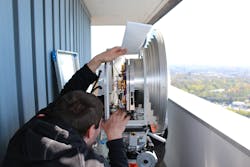Researchers Claim Record for Terrestrial Radio Transmission
Nearly two centuries after Doctor Frankenstein – the fervent young man in Mary Shelley’s gothic novel – proclaimed that he would walk through the footsteps of earlier scientists in bringing his creature to life, wireless engineers are taking a similar route to innovation.
Engineers have been tweaking the wireless components used to access lower frequency bands in an attempt to handle spectrum that has long avoided the tentacles of wireless data. The idea is to divert huge amounts of data clogging the airwaves into higher frequency bands like millimeter waves.
The latest example of that work came from a research team from Germany’s Fraunhofer Institute for Applied Solid State Physics and the University of Stuttgart. The engineers invented a radio that could transmit data around six gigabits per second over almost 40 kilometers. The Fraunhofer Institute called the accomplished "a world record in terrestrial radio transmission.”
Using highly-efficient transmitters and receivers, the radio transferred the entire contents of a DVD in less than 10 seconds. The research team exploited part of the wireless spectrum known as the E band. Occupying the range between 71 and 76 GHz, the frequency band is normally reserved for broadcast and satellite television signals.
That spectrum falls within the range of millimeter waves, which have quickly turned into the next frontier for wireless carriers seeking faster download speeds and greater network capacity. In the United States, the Federal Communications Commission has singled out the 73 GHz as one of the initial candidate for licensing.
Ingmar Kalfass from the Institute of Robust Power Semiconductor Systems from the University of Stuttgart led the research team, which created two new high-frequency designs to help speed the radio transmission.
The first technology was located in the transmitter, where amplifiers based on gallium-nitride increased the power of the broadband signal to 1 watt. That relatively high power helped to account for the tendency of millimeter waves to weaken over long distances. The transmitter, located in the town of Cologne, Germany, sent out the signal through a parabolic antenna.
The second innovation was in the receiver, which was located 36.7 kilometers away in the town of Wachtberg. It contained special low-noise amplifiers based on indium gallium-arsenide semiconductors. The transistors within that material exhibit high electron mobility, a property that makes them more sensitive to higher frequencies. This helped the receiver to read the weakened signals coming from the transmitter.
The researchers envision similar technologies using millimeter waves to replace optical fiber and connect cellular base stations in mobile backhaul. These systems could also help offload data from satellite communications, which frequently rely on the E band. In fact, that was the original goal of the research project, also known as the Advanced E Band Satellite Link Studies (ACCESS).
“The unabatedly increasing demand for ever-higher data rates in fiber-based and wireless communication networks can only be mastered by technological innovations in the network infrastructure,” the research team said in a statement.
That vision is shared by Germany's Federal Ministry for Economy and Energy, which funded the research project as part of an ongoing initiative to transform factories and cities with big data. Transmitting all that information — gathered from sensors and other equipment — into the cloud is expected to take wireless infrastructure to its limits.
The research team will continue to refine the technology in the next phase of their research, a project known as the E Band Link Platform and Test for Satellite Communications, or ECLIPSE. They will focus primarily on connecting satellites in orbit with extremely fast wireless links.
About the Author

James Morra
Senior Editor
James Morra is the senior editor for Electronic Design, covering the semiconductor industry and new technology trends, with a focus on power electronics and power management. He also reports on the business behind electrical engineering, including the electronics supply chain. He joined Electronic Design in 2015 and is based in Chicago, Illinois.

